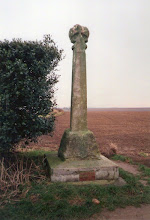A bloke needs a shed. I have one, but it has been perpetually full of junk for years now (good junk, but full nonetheless). But, after a number of merciless 'chucking sessions' in recent weeks, I have finally come to the point where the shed becomes a plausible gaming venue – even if it is somewhat lacking in creature comforts (e.g. leaking roof (not over the tables), hot in summer and cold in winter).
 |
| A New Hope! Wargaming in the shed! |
I've been keen to get some serious gameplay under my belt using the Too Fat Lardies classic,
If the Lord Spares Us (WW1 in the Middle east). Previously, trying to war-game in a busy household had led to rushed set-ups, late at night when all was quiet, only to have to pack up after a few turns to clear the decks for morning. No longer shall the domestic needs of the many curtail the wargaming needs of the few (well, me).
So, my first decent attempt at ITLSU with my
Eureka Miniatures 15mm troops, was a 'somewhere in Palestine' encounter where a brigade of British infantry supported by a troop of armoured cars, assault and Ottoman stronghold surrounding an Oasis town of El-Gouna. The British have occupied a small Oasis from where they will launch their attack. but not enough to maintain their current position. Their only hope is to capture the wells held by Johnny Turk, a few miles to the
The task of capturing El-Gouna and its wells, intact, fell to Brigadier-General A.W. Tufnel (classified as an Eaton commander) and the 126th East Lancashire Brigade:
- 1st Battalion, 4 companies of 4 bases, infantry + 1 x MG (Jolly Good Fellows, spunk rating 0)
- 2nd Battalion, 4 companies of 4 bases, infantry + 1 x MG (Saturday Boys, spunk rating 1)
- 3rd Battalion, 4 companies of 4 bases, infantry + 1 x MG (Saturday Boys, spunk rating 1)
- 2 Armoured cars (1 base, Jolly Good Fellows, spunk rating 0)
 |
| Initial deployment with the Ottoman forces deployed in two redoubts overlooking the oasis. I randomly allocate troops to each blind once they are spotted or choose to come out of cover. The Empire troops have limited water at this oasis (bottom of picture) but must push on to secure the more reliable water supply at El-Gouna. |
 |
| The Empire troops advance cautiously across the open ground before El Gouna. On the British left cover is taken behind a rocky hill. |
 |
| The Empire forces are spotted from the air by a lone Taube (due to the Biggles card turning up this turn). |
I've never found time to finish this post so will upload the pictures I have to hand. Ultimately, the British force managed to push the Turks off the hill on their left (by sweeping around the wire). However, the Turks managed to hold the hill on the British right flank.
 |
| The 3rd battalion of the East Lancs in the British centre manages to push along the wadi with support from a pair of armoured cars on their left. This was the beginning of the end for the Turkish defence. |

























